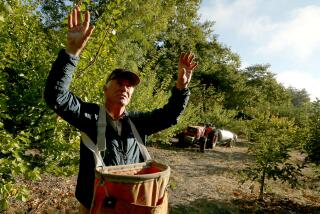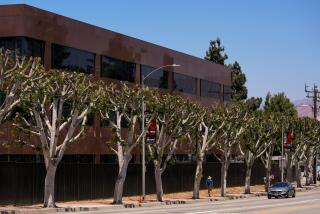Gerdening : When Planting, How About Them Fuji Apples? : Fruit: The prized Japanese apple can be grown successfully in mild Southland climate, as can several other varieties.
- Share via
Most apple trees don’t produce well in the Southland. It simply doesn’t get cold enough to provide them with the number of chilling hours they require. Popular varieties such as Red Delicious and McIntosh will bear fruit only in the colder and higher elevation growing areas.
In recent years, however, pomologists have made considerable strides toward developing apple varieties suited to our mild climate. And there is great news for apple aficionados--the prized Fuji apple will probably produce well in many areas of the Southland. I say “probably” because my 4-year-old Fuji tree has produced a good crop in the mild-climate area of Orange County where I live.
For those not familiar with Fuji apples, they are the hottest commercial apple around. They have only become available in local markets during the last three or four years--and at extravagant prices--as high as $2 a pound. Who would pay that for a pound for apples? Lots of people would once they tasted the Fuji.
The Fuji apple comes from Japan, where it’s the most popular apple in that country----with good reason. It is very sweet, firm, crunchy and keeps marvelously well without losing its quality--often up to six months if refrigerated. Fujis aren’t particularly pretty apples. They are large, solid and usually greenish-yellow, overlayed with red or russet. Ah, but the flavor--in my opinion it is the best flavored apple around, and I’ll confess I’ve paid $2 a pound for Fujis.
When I planted my Fuji tree, I didn’t really expect it to do very well because of my mild climatic zone; but I was pleasantly surprised. According to Steve Sibbert, an apple specialist at the University of California Cooperative Extension in Visalia (near the heart of California’s commercial Fuji growing area), there is no reason Fujis should not produce satisfactorily in most of the Southland.
Silbert said that in some of the Fuji growing regions in Japan, the climate is quite mild. He cautioned that Fuji trees might not produce well in all Southern California growing zones, and that production might be spotty from year to year, but in general the trees should do fine.
Sibbert also said that fire blight may be a problem because of our spring weather conditions. I haven’t experienced fire blight with my tree, but that doesn’t mean I won’t experience it.
In talking with several wholesale nursery growers, I learned that there should be an ample supply of Fuji trees in local nurseries this bare-root season. It is important to note that the Fuji apple tree requires another apple tree planted in close proximity for proper pollination. I have a Dorsett Golden apple tree near my Fuji and I would recomment it as a pollinator tree.
Although the Fuji wasn’t bred to be a mild-climate apple, others have been. Here’s a rundown of some of the better low-chill apple varieties that will produce well in most of Southern California:
Dorsett Golden. A highly productive apple with a flavor and texture that resembles Golden Delicious, except that the flavor is slightly more tart. It doesn’t have the coloring of Golden Delicious; the skin is more of a rich yellow color blushed with red. It is an early producer, usually starting in June. Does not store well.
Anna. The flavor of this apple brings rave reviews--sweet, with a crisp juicy texture; a prime dessert fruit. Color is greenish, splashed with a good deal of red. Early producer; fruit does not store well. Needs Dorsett Golden as a companion tree pollinator.
Early Dawn. Produces beautiful yellow fruit blushed with red. The flavor could be described as tart-sweet and it is highly aromatic. Harvest period begins in August.
Gorden Apple. A large, plump apple that is green with red striping and a unique sweet-tart flavor. Good for fresh eating and makes delicious pies. Heavy producer from mid-August through October.
Ein Shemer. Large, early apple, similar to Golden Delicious. An import from Israel that is very productive. Does not store well.
Pettingill. A large, old-fashioned variety that has been grown for a long time in Southern California. It has a very low chilling requirement and will produce fruit in beach areas where most other apples won’t. Harvest begins in August.
Two other apple varieties, Beverly Hills and Winter Banana, produce well in the Southland, however, in my opinion their quality won’t match the others.
Now, during bare-root season, is the time to plant apple trees. After purchasing your tree, choose a sunny site and dig a hole twice as wide, but just as deep as the root system. Fill the hole with water. Let the water drain completely and fill it again. If the water does not drain within 12 hours, choose another site or refer to a soil guide for correction methods. Improper drainage is the main reason that young trees don’t survive. If the hole passes the test, place the tree in it and refill with the original soil.
Planting time is a good time for adding slow-release fertilizer tablets, which provide nutrients for a long period without burning the roots. Follow label directions carefully. These tablets also are ideal for fertilizing the established trees. To provide the roots with sufficient moisture, be sure to water sufficiently during the planting process.
Establish a weekly watering routine (in the absence of rain). Deep watering is vital, but avoid soaking the lower trunk area. Trickle irrigation is best.
Apples need thinning. After the first fruit drop, thin the remaining fruit to one or two apples per cluster.
More to Read
Eat your way across L.A.
Get our weekly Tasting Notes newsletter for reviews, news and more.
You may occasionally receive promotional content from the Los Angeles Times.










